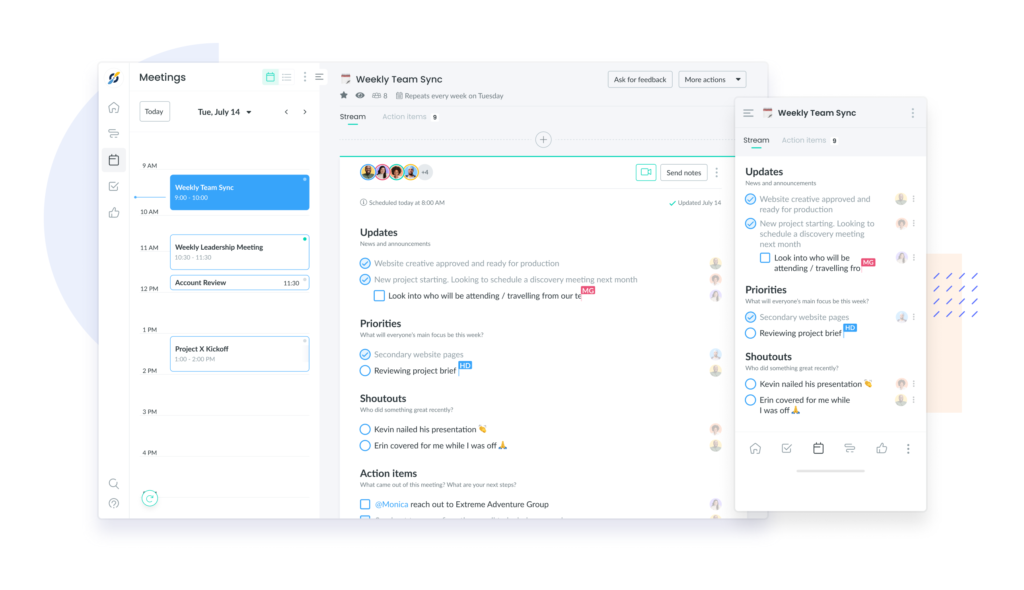How To Run Daily Standups: A Guide for Managers
Daily standups can help your team remove blockers, clarify objectives, and communicate effectively. Here’s how to make them count.
Daily standups have become a common ritual for many teams. However, there are some practices that distinguish effective standups from meetings that aren’t productive.
Curious to know how high-performing teams run their daily standups? We’ve put together the best tips and tricks, plus a great standup meeting template for your team.
- What is a daily standup meeting?
- What are the benefits of daily standups?
- Standup meeting template
- 5 Tips to run effective standups
- Common mistakes to avoid
- Alternatives to daily standup meetings
The daily standup meeting – also known as a scrum, or daily scrum – is a 15-minute get-together that helps teams stay aligned and prepare to have a productive day.
What are the benefits of daily standups?
Daily standups can help you remove blockers, clarify team objectives, and encourage your teammates to communicate with each other.
The purpose of these meetings is to verify the team’s progress on the sprint plan – or list of priorities – that was discussed at your weekly team meeting.
“Done right, the daily standup is an important time for the team to sync on where they are, and to determine what they need to do to successfully complete the sprint,” says Dwight Kingdon, an enterprise agile coach.
A daily standup can be a great tool to stay focused and ensure that everyone is working towards the same goal. According to Jason Yip, a senior agile coach at Spotify, standups can also help you understand if your team feels comfortable bringing up challenges and asking each other for support:
“One of the primary benefits of a team versus working alone, is that team members can help each other when someone encounters a problem or discovers a better way of doing something,” says Yip. “A ‘team’ where team members are not comfortable sharing problems and/or do not help each other tends to be ineffective.”
Standup meeting template
Yesterday. Today. Obstacles.
That’s it – the only three things that should be discussed at your daily standups.
1 What did I accomplish yesterday?
Share your progress on the sprint goals, focusing on the activities that are relevant to the team as a whole.
2 What will I do today?
Mention all the things you plan to accomplish today – knowing that you’ll be held accountable for those things in tomorrow’s daily standup meeting.
3 What obstacles are impeding my progress?
Let other people in the team know if there’s anything preventing you from getting your work done. This includes any cross-departmental blockers, dependencies, and technical limitations.

Of course, you can always switch up the standup questions to match your team’s style. For example, Jonathan Rasmusson describes using the following agenda with his team in the book The Agile Samurai:
- What you did to change the world yesterday?
- How you are going to crush it today?
- How you are going to blast through any obstacles unfortunate enough to be standing in your way?
“Answering these types of questions completely changes the dynamic of the stand-up. Instead of just standing there and giving an update, you are now laying it all the line and declaring your intent to the universe,” says Rasmusson.
A critical part of making sure standups stay on track is setting a time limit per person and setting expectations about the amount of time you have to talk. Too often 15-minute meetings turn into 45-minute ones because people talk about what they’re working on in way too much detail, and it throws everything off track.

Pro tip
Use a meeting management tool like Fellow to run daily standup meetings that inspire productivity and collaboration!

5 actionable tips to run an effective standup
Now that you know the three things that the team should discuss, it’s time to talk about the best practices you should adopt in order to have productive standups.
According to Eric Wadsworth, senior software developer at Ancestry, the best daily standups happen when:
- The team meets early in the day – ideally within 30 minutes of people arriving.
- Everyone stands up and respects the time limit – this keeps the meeting short.
- You go around the circle in sequence rather than skipping around.
- Everyone restricts their update to the [yesterday – today – obstacles] format.
- Items that take longer than a few minutes to discuss are tagged “post-standup” and addressed after the group meeting.

Common mistakes to avoid at your daily standups
1 Reporting only to the manager
The purpose of a daily standup is to foster communication and collaboration across your team. That’s why one of the most common indicators that your standups are running poorly is when people report their updates directly to you (the manager) – instead of addressing everyone on the team:
“This indicates that the daily stand-up is for the manager/facilitator when it is actually supposed to be for the team,” says Jason Yip. “There are various ways to break this dependence: Rotate the Facilitator, Break Eye Contact, change the form of Yesterday Today Obstacles, use Pass the Token, etc.”
This also means that the standup shouldn’t be cancelled just because you (the team lead) can’t attend.
2 Obstacles aren’t discussed … and tracked!
Daily standups can help you find sources for pressing problems and come up with actionable and timely solutions. But this can only occur if people on your team are bringing up their issues:
“Talking about problems takes courage. It is important that your team has that courage, talks about problems and does something to solve them,” says Matthias Orgler, a scrum master and agile coach.
If your team members aren’t bringing up their obstacles and challenges, you should encourage them to do so. You can also keep an eye on the following reasons why employees might not be raising obstacles during your daily standups:
- Lack of trust between team members.
- Lack of trust that the obstacles will be removed – because nobody took action when other issues were raised before.
- Lack of preparation.
💡 Pro tip: If blockers come up during your daily standup, make sure to track them down. This will help you identify the progress of their resolution and understand what kind of issues are occurring most frequently:
“The simple act of writing an issue down and therefore explicitly acknowledging it is a very reliable way to reduce drawn-out conversations,” says Jason Yip. “Including an occurrence count with each raised obstacle highlights which issues are generally more important to deal with first.”
3 Not being ready for the meeting
“What did I do yesterday?…. I can’t remember… What am I doing today?…. Let me think…”
Those are the answers you’ll get if people don’t prepare for your meeting.
Here’s a practical way to encourage preparation for your daily stand-ups: Ask your teammates to write down their answers in the meeting agenda before the meeting begins.
This will help you ensure that people come prepared and will be a great way to track the things that they promise, as well as the obstacles impeding their progress.
Alternatives to daily standup meetings
The truth is, not all teams are equal. As with any meeting, you should only hold daily standups if your team is benefiting from them.
As Julie Zhuo, Facebook’s VP of Product Design, emphasizes in The Making of a Manager, the only way to know if your meetings are working is by asking your teammates for feedback:
“I had seen other managers run similar status or stand-up meetings, and I thought this was standard practice for keeping folks in the loop about what was going on,” says Zhuo. “After a few months, it became clear that this meeting was the work equivalent of a history teacher droning on about some battle in the year 1752.”
In the book, Zhuo recalls receiving an email from one of her direct reports, asking if she would consider replacing the daily standups for an email:
“Gutsy move, telling your manager her meeting sucks. But the feedback was spot-on. I cancelled the series, and we went to weekly email updates, which worked out beautifully,” says Zhuo. “I left with a deeper appreciation of both the importance of planning good meetings and the value of giving feedback to improve bad meetings.”
On that note, here are some alternatives to daily standups that other managers are using, and you can try out too:
- Creating a #standup channel on Slack, where people post what tasks they’re working on and report roadblocks.
- Using a collaborative tool like Fellow.app to write down updates and challenges.
- Hosting one standup meeting on Wednesday or Thursday, instead of every day of the week.
💡 Pro tip: Virtual standups (where you post in a channel as opposed to meeting over a video call) are a good alternative for remote teams working in different timezones, since you don’t have to find a time that works for everyone.
TL;DR [Conclusion]
Daily standups can help you remove blockers and encourage internal communication. These meetings can be very effective when people come prepared, address the entire team (not only the manager), and bring up their roadblocks and concerns.
Everyone should answer the following three questions:
- What did I accomplish yesterday?
- What will I do today?
- What obstacles are impeding my progress?
And if you need a meeting agenda tool to track the team’s roadblocks and updates, you can check out Fellow.











